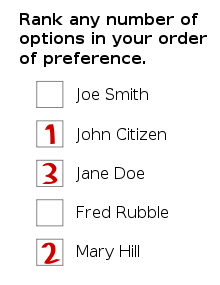 Global Information
Global InformationCondorcet method information
| Part of the Politics series |
| Electoral systems |
|---|
 |
|
|

A Condorcet method (English: /kɒndɔːrˈseɪ/; French: [kɔ̃dɔʁsɛ]) is an election method that elects the candidate who wins a majority of the vote in every head-to-head election against each of the other candidates, whenever there is such a candidate. A candidate with this property, the pairwise champion or beats-all winner, is formally called the Condorcet winner.[1] The head-to-head elections need not be done separately; a voter's choice within any given pair can be determined from the ranking.[2][3]
Some elections may not yield a Condorcet winner because voter preferences may be cyclic—that is, it is possible that every candidate has an opponent that defeats them in a two-candidate contest.[4] The possibility of such cyclic preferences is known as the Condorcet paradox. However, a smallest group of candidates that beat all candidates not in the group, known as the Smith set, always exists. The Smith set is guaranteed to have the Condorcet winner in it should one exist. Many Condorcet methods elect a candidate who is in the Smith set absent a Condorcet winner, and is thus said to be "Smith-efficient".[5]
Condorcet voting methods are named for the 18th-century French mathematician and philosopher Marie Jean Antoine Nicolas Caritat, the Marquis de Condorcet, who championed such systems. However, Ramon Llull devised the earliest known Condorcet method in 1299.[6] It was equivalent to Copeland's method in cases with no pairwise ties.[7]
Condorcet methods may use preferential ranked, rated vote ballots, or explicit votes between all pairs of candidates. Most Condorcet methods employ a single round of preferential voting, in which each voter ranks the candidates from most (marked as number 1) to least preferred (marked with a higher number). A voter's ranking is often called their order of preference. Votes can be tallied in many ways to find a winner. All Condorcet methods will elect the Condorcet winner if there is one. If there is no Condorcet winner different Condorcet-compliant methods may elect different winners in the case of a cycle—Condorcet methods differ on which other criteria they satisfy.
The procedure given in Robert's Rules of Order for voting on motions and amendments is also a Condorcet method, even though the voters do not vote by expressing their orders of preference.[8] There are multiple rounds of voting, and in each round the vote is between two of the alternatives. The loser (by majority rule) of a pairing is eliminated, and the winner of a pairing survives to be paired in a later round against another alternative. Eventually, only one alternative remains, and it is the winner. This is analogous to a single-winner or round-robin tournament; the total number of pairings is one less than the number of alternatives. Since a Condorcet winner will win by majority rule in each of its pairings, it will never be eliminated by Robert's Rules. But this method cannot reveal a voting paradox in which there is no Condorcet winner and a majority prefer an early loser over the eventual winner (though it will always elect someone in the Smith set). A considerable portion of the literature on social choice theory is about the properties of this method since it is widely used and is used by important organizations (legislatures, councils, committees, etc.). It is not practical for use in public elections, however, since its multiple rounds of voting would be very expensive for voters, for candidates, and for governments to administer.
- ^ Gehrlein, William V.; Valognes, Fabrice (2001). "Condorcet efficiency: A preference for indifference". Social Choice and Welfare. 18: 193–205. doi:10.1007/s003550000071. S2CID 10493112.
The Condorcet winner in an election is the candidate who would be able to defeat all other candidates in a series of pairwise elections.
- ^ Green-Armytage, James (2011). "Four Condorcet-Hare Hybrid Methods for Single-Winner Elections" (PDF). S2CID 15220771. Archived (PDF) from the original on 2013-06-03.
- ^ Wallis, W. D. (2014). "Simple Elections II: Condorcet's Method". The Mathematics of Elections and Voting. Springer. pp. 19–32. doi:10.1007/978-3-319-09810-4_3. ISBN 978-3-319-09809-8.
- ^ Gehrlein, William V.; Fishburn, Peter C. (1976). "Condorcet's Paradox and Anonymous Preference Profiles". Public Choice. 26: 1–18. doi:10.1007/BF01725789. JSTOR 30022874?seq=1. S2CID 153482816.
Condorcet's paradox [6] of simple majority voting occurs in a voting situation [...] if for every alternative there is a second alternative which more voters prefer to the first alternative than conversely.
- ^ http://pj.freefaculty.org/Papers/Ukraine/PJ3_VotingSystemsEssay.pdf Voting Systems "Formally, the Smith set is defined as the smaller of two sets: 1. The set of all alternatives, X. 2. A subset A ⊂ X such that each member of A can defeat every member of X that is 36 not in A, which we call B=X − A."
- ^ G. Hägele and F. Pukelsheim (2001). "Llull's writings on electoral systems". Studia Lulliana. 41: 3–38. Archived from the original on 2006-02-07.
- ^ Colomer, Josep (2013). "Ramon Llull: From Ars Electionis to Social Choice Theory". Social Choice and Welfare. 40 (2): 317–328. doi:10.1007/s00355-011-0598-2. hdl:10261/125715. S2CID 43015882.
- ^ McLean, Iain; Urken, Arnold B. (1992). "Did Jefferson or Madison understand Condorcet's theory of social choice?". Public Choice. 73 (4): 445–457. doi:10.1007/BF01789561. S2CID 145167169.
Binary procedures of the Jefferson/Robert variety will select the Condorcet winner if one exists